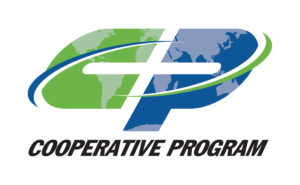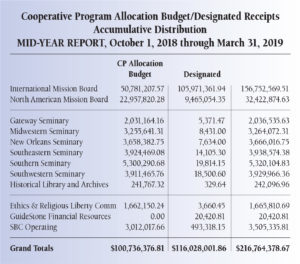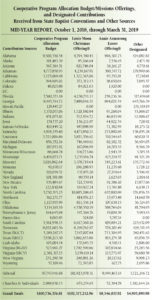

The churches that network together to support the mission and ministries of the Southern Baptist Convention voluntarily choose to cooperate with one another.
These churches, known as “cooperating churches,” believe that each accomplishes more when they work together in harmony. They believe their combined resources empower them to make a Kingdom impact that touches their own neighborhoods, their surrounding region, their respective states, and even the farthest reaches of our nation and the world.
The most important benefits of being part of a ministry organization like the SBC are spiritual and intangible.
It is natural and biblical that churches would take the opportunity to identify with like-minded churches. This allows each church to be a part of a larger enterprise, pooling their resources to establish and advance Great Commission work. This loose-knit family structure creates a synergy in which the impact of the whole is greater than the sum of the individual parts, giving churches a way collectively to express their convictions and realize their vision.
Each cooperating church, regardless of size, location, language, worship style, or ethnicity, contributes to this synergy. It is amazing what can happen when thousands of like-minded churches and millions of like-minded followers of Christ band together to accomplish Kingdom-sized initiatives.
Such cooperation promotes a strong esprit de corps with men and women who share a common missional vision of reaching their neighborhoods and the nations with the life-changing power of the Gospel.
Financial contributions through the Cooperative Program and special offerings help underwrite the world’s most effective mission-sending agencies in history, the nation’s largest consortium of theological seminaries, and the godly influence the Ethics and Religious Liberty Commission brings to the public square.
Leaders of cooperating local churches form the talent pool from which leadership and oversight of the Convention’s various cooperative ministries are selected. Members of these same churches are the volunteer base of every Convention ministry effort, whether Disaster Relief or trustee service, foster parenting or Convention committee work. Being informed of SBC initiatives, these volunteers choose to give of their time, talents, and resources to the various ministry initiatives of the Convention and its entities.
The credibility and ministry of each local church contributes positively to the public image of the Southern Baptist Convention, while the networking and fellowship of the members of cooperating churches promote a sense of accomplishment that the Convention is making a difference in people’s lives.
Not all benefits of cooperation, however, are intangible. Each cooperating church, regardless of size or ability to contribute, qualifies for messengers the churches themselves elect. Each messenger has a voice and a vote at the SBC annual meeting. These messengers determine the missions and ministry priorities of the Convention and select the trustees that govern each ministry entity.
Because of Cooperative Program gifts from thousands of churches, church-endorsed seminary students are given opportunity to prepare for ministry at below-market costs and, upon graduation, are able to serve churches of any size.
God-called missionaries can serve overseas without the need to cut short their field assignments to raise money.
Church planters across the United States and Canada are part of a network that provides ongoing training and multiple avenues of support and encouragement.
Pastors and other church staff members qualify to participate in GuideStone’s retirement, health, disability, and life insurance plans, and to benefit from the numerous ministry tools produced by LifeWay Christian Resources.
12 The number of ministry and facilitating entities that serve the missions and ministry initiatives of the Southern Baptist Convention — two mission boards, six seminaries, GuideStone, LifeWay, Ethics and Religious Liberty Commission, and the Executive Committee.
624 The number of new churches planted by Southern Baptists in the United States and Canada during the past year as reported by the North American Mission Board, bringing to 7,593 the number of churches planted since 2010, according to NAMB’s report in the Book of Reports. These churches accounted for 18 percent of all reported baptisms by Southern Baptist churches and 71 percent of baptisms among Canadian Baptists in 2017, according to a report by NAMB president Kevin Ezell at its May trustee meeting.
3,692 The number of overseas field personnel working overseas through the ministries of IMB as of April 30. IMB’s Fast Facts were updated on May 31 after this issue went to print (May 28) and will include the 26 newly-appointed missionaries commissioned by IMB on May 23.
22,808 The total number of students receiving training through the ministries of our six Southern Baptist Convention seminaries through residency, extension, and online courses, with a FTE (full-time equivalency) of 8,079 students. 1,669 basic degrees were awarded in 2017–2018—691 MDiv, 121 ThM, and 857 MA and other two-year seminary degrees.
4.82 The average percentage of total undesignated gifts received by cooperating churches that was forwarded through the Cooperative Program to support the mission and ministry causes of 41 state Baptist conventions and the SBC. Last year’s total CP was $463,076,368, with $266,031,540 used for hundreds of ministries through the states and $197,044,828 forwarded for Southern Baptist Convention missions and ministries.
Click each chart to view larger.

















